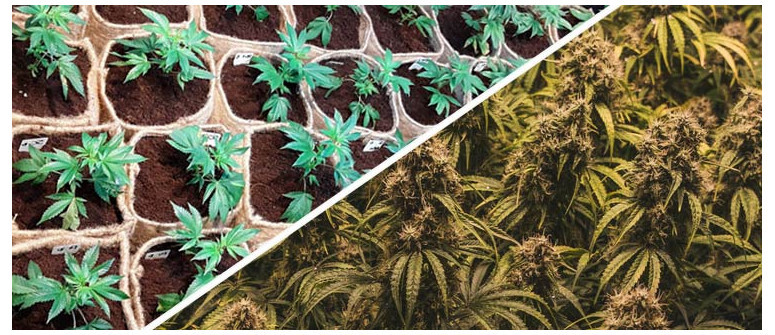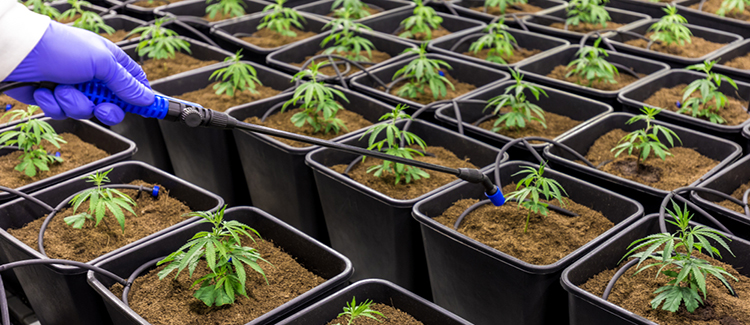Achieve bigger cannabis yields with Sea of Green (SOG)

If the thought of dozens of flowering cannabis plants sounds like a dream come true, it's time to make that dream a reality with the sea of green (SOG) method. We're going to cover everything you need to know about this indoor-friendly practice, so keep reading.
Contents:
Many indoor cannabis growers have the same goal in mind—maximising space to cultivate as many plants as possible. That's where the sea of green method (SOG for short) comes in. It’s a beginner-friendly way to optimise space, without starving your plants of the resources they need for bigger, better yields.
What Is the Sea of Green Method (SOG) and How Does It Work?
Sea of green involves growing several small plants close to one another, fitting as many as possible per square foot (or per square metre). In a traditional growing setup, you let a handful of cannabis plants reach their full potential over several months. Sea of green works oppositely to achieve the same result. You use the same space to grow numerous small cannabis plants, and, in the end, lots of small colas add up to a similar yield as several large plants.
The SOG method may seem detrimental to the goal of greater yields, but the final result is usually the same, if not better. And, as an added benefit, you can harvest in a lot less time than with a handful of larger plants. Plus, when the SOG method is underway, you'll have a luscious, thick upper canopy of buds, hence the name "sea of green"—what's not to love about that?
Advantages of Sea of Green Method for Growing Cannabis
- Short vegetative stage (shorter overall life cycle)
- Maximises indoor growing space
- Works in smaller grow spaces
- Low-stress technique
- Suitable for beginners
- Minimal topping or trimming needed
Disadvantages of Sea of Green Method for Growing Cannabis
- Requires even light distribution
- Clones are preferable for best results
- Understanding of light cycles needed to initiate early flowering
- Increased risk of mould and mildew
- Regular maintenance of several plants is time-consuming
Sea of Green (SOG) vs Screen of Green (ScrOG)
The principles of SOG and ScrOG (screen of green) are similar, so the two techniques are often confused. However, there are subtle differences to note:
- SOG method involves growing several plants with only a handful of lateral branches. Minimal branching ensures a nice central cola, which is crucial when you're growing as many plants as possible in a small grow room.
- ScrOG, on the other hand, encourages lateral branching to maximise bud sites. To ensure flowers get the light they need, you use a net or horizontal wire trellis to train branches. By continually tucking new growth under the screen, you create an even canopy of buds.
SOG is the more beginner-friendly option as plants need little training, and, for the most part, are left to their own devices. Of course, if you notice plants getting out of control, there's no reason you can't introduce a screen later on. Provided you can keep up with the training, ScrOG is also an excellent way of keeping yields on track, especially if your cannabis plants grow at different rates.
No matter which growing method you use, both make excellent use of available grow space and ensure your operation is as efficient as possible. In essence, a SOG canopy is made up of individual, large colas from each plant, while a ScrOG canopy is made up of numerous branches from one or more larger plants.
What Are the Best Strains for SOG?
Strain choice plays a vital role in the SOG method. Why? Because you want to focus on cultivars that have traits aligned with the method’s requirements; strains that naturally develop a sizeable central cola while staying relatively small in stature. Beginning with these types of cannabis genetics will make sure your SOG setup is significantly easier to maintain.
To help narrow down your strain choice, stick to indicas or indica-dominant hybrids. Their compact stature will help you keep things under control, and a single primary cola caters to the fundamental principles of the SOG method.
You can go with sativa strains if you really want, but you'll need to make sure you top plants well before initiating flowering to stop them from stretching and creating an uneven canopy. Sativas are a better pick for ScrOG setups overall.
Sea of Green With Autoflowers or Clones
So far, we've only referenced using photoperiod strains, and implementing SOG with strains grown from seeds. Although both make good candidates for SOG, they aren't the ideal option.
Clones
To maintain a robust, homogeneous sea of green, clones are the way to go. Clones from a stable mother plant have one significant advantage over their seed-sprouting counterparts—uniformity.
Provided you keep conditions consistent among all plants, clones grown from cuttings will develop exactly the same. Uniformity is the name of the game when practising SOG, so clones are ideal. And, once you've finished one round of SOG, you can take cuttings from the plants you're happiest with and start all over again.
Autoflowers
Autoflowers are another popular option for SOG because they already have the traits we desire. Autos flower quickly and typically grow shorter than photoperiod variants. You also don't need to worry about switching them to flowering with light manipulation—they do that job for you!
SOG also helps circumvent a potential downside to autos—their struggle with any type of high-stress training. The low-stress approach of sea of green is an excellent way to capitalise on yields without stress ruining your harvest. If you do opt to use sea of green with autos, remember that you still want uniformity between plants, so stick to the same strain.
How To Grow Cannabis With Sea of Green
With the fundamentals of sea of green covered, it's time to move on to the most important aspect—implementation.

Setting up Sea of Green
- Strain selection: We've already highlighted the importance of strain selection, but it's worth mentioning again. Stick to the same strain, and use cuttings to make sure plants grow uniformly. If you grow from seeds and plants start to get out of control, restore order with ScrOG.
- Pot size: Restricting cannabis' pot size helps to keep its total height under control. So you don't run into issues with airflow or maintenance, keeping plants small is crucial. A 4–6-litre pot should equate to a fully mature plant of around 30–50cm in height. To make life easier, you'll want to germinate seeds in their final pot.
- Spacing: Optimal spacing is about one or two plants per square foot (around 4–16 plants per square metre). Any more than that, and you may run into issues with air circulation. Any less, and you won't get that luscious green canopy of buds. If you're new to cannabis growing, stay conservative until you have a better understanding of the strain you're dealing with.
Vegetative Stage
- Topping: Best practice is to top plants once they reach the four-week mark so they stay at a similar size and shape. This also ties in with the switch to flowering (more detail below). If you'd rather keep things simple, topping isn’t necessary, but don't lose sight of the even canopy needed to make SOG effective.
- We want plants to stay small, but, in some cases, it's worth waiting an extra week or two if your grow room can accommodate it. Ultimately, you'll have to use your best judgement and experience to decide when to top for best results.
- Switching to flowering stage: At the same point you finish topping, you'll want to switch plants to a 12/12 light schedule. The transition will prompt cannabis plants to enter the flowering stage, and ensure their focus goes into bud development and nothing else.
Also, be aware that many strains like to stretch after the initial flip to flowering. Keep an eye on plants during this crucial period and trim any rogue branches. If plants start spiralling out of control, don't be afraid to switch to a ScrOG setup to avoid wasting your hard work.
Flowering Stage
- Airflow: Obviously, plants will need water, nutrients, and light, but airflow management is a crucial consideration for the sea of green method. It's not too much of an issue with young seedlings, but as plants get bigger and enter the flowering stage, poor air circulation can lead to mould. With plants positioned closely together, just one case of bud rot will easily wipe out your entire crop. Best practice is to promote air circulation both above and below the canopy.
- Trimming: As your sea of green takes shape, the lower parts of your cannabis plants will struggle with light exposure. To avoid any wasted effort from your plants, trim foliage hidden beneath the canopy. Don't be too conservative either. These branches and leaves are unnecessary, and they hinder the air circulation required to keep conditions optimal.
Mastering the Sea of Green (SOG) Technique
It doesn't take much to master the sea of green technique. Provided you stick to the method's core principles, it's an effective way for beginner growers to cultivate several plants at once. In the hands of an expert, sea of green can make for some truly incredible results.
Just like any other cannabis growing method, it always comes down to preparation. Start by calculating how many plants per square foot or square metre you can fit in your grow room, take time picking a strain, and keep the pot size small—the rest should mostly take care of itself.
Sea of green makes the most of your grow space, with the potential to deliver a motherload of fat, juicy colas. And, if you still feel unsure, just remember; it's not the size that matters, it's what you do with it.
.jpg)
.jpg)

.jpg)

